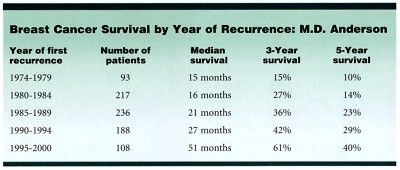Survival After First Recurrence Has Improved Over 25 Years
ORLANDO-A large review of patients treated at M.D. Anderson Cancer Center suggests that survival after a first breast cancer recurrence has greatly improved over time in patients diagnosed in the last 25 years. The investigators believe that new therapies, above and beyond the anthracyclines, may be affecting survival rates.
ORLANDOA large review of patients treated at M.D. Anderson Cancer Center suggests that survival after a first breast cancer recurrence has greatly improved over time in patients diagnosed in the last 25 years. The investigators believe that new therapies, above and beyond the anthracyclines, may be affecting survival rates.
Consecutive series of adjuvant therapy studies from M.D. Anderson have previously shown that anthracycline-based regimens decrease breast cancer recurrence and death. Since the emergence of anthracyclines, multiple new treatment modalities, including new hormonal, biologic, and cytotoxic agents, have been developed, but their effect on survival has been unclear.
This study analyzed patients who were treated in consecutive series of anthracycline-based adjuvant therapy protocols to determine if survival from time of first recurrence improved between 1974 and 2000.
"These patients were uniformly treated and followed at a single institution, and so provide a unique opportunity to evaluate possible changes in survival over time," said Sharon Giordano, MD, assistant professor, M.D. Anderson Cancer Center, who presented the study at a poster session of the 38th Annual Meeting of the American Society of Clinical Oncology (abstract 212).
A total of 1,986 patients were treated on five consecutive anthracycline-based adjuvant therapy regimens from 1974 to 1994. The 842 patients who developed recurrent disease were divided into five groups based on year of first recurrence. Median and 3- and 5-year overall survival rates from time of first recurrence were compared among the groups.
Differences among the groups were clearly evident in terms of survival, as shown in the Table below. By log rank analysis, there was a highly statistically significant improvement in survival from time of first recurrence across the five groups (
P
< .001). The results were consistent across all the tumor stages, and improved progressively with each 5-year treatment period, Dr. Giordano reported.

The patient characteristics upon initial diagnosis changed somewhat over time, shifting toward more stage I patients in recent years and fewer advanced stage patients at diagnosis, Dr. Giordano said. Thus, the improvement in survival could have been confounded by the unequal distribution of this prognostic factor. However, she said, when the data were stratified by initial stage, the finding of improved survival was still present. "These differences were not factors in survival, which was evaluated from first recurrence and not linked to initial disease factors," she commented.
The investigators believe that the differences in survival after a first recurrence among the groups reflect a combination of factors: the development of new chemotherapy agents and regimens and new hormonal therapies, the use of bisphosphonates, and improvements in supportive care.